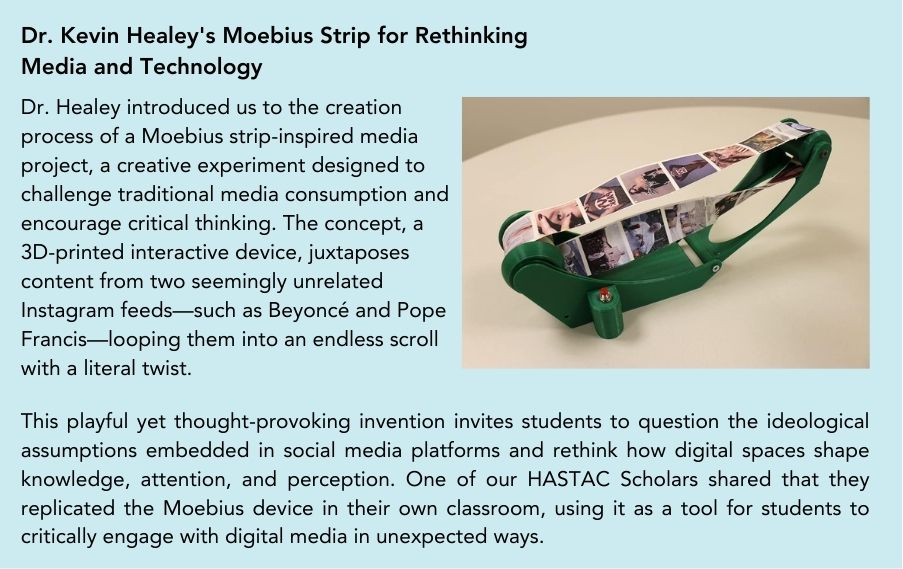“ There’s an entire other world we just haven’t created yet. Find the people who will help build this world that doesn’t exist yet. Let’s create it together.”
Dr. Jade E. Davis
“Every new technology that comes out has a particular viewpoint embedded within it. You could use it as intended, but I choose to use it differently. And if that disrupts their vision of where the world should be going, great—because they’re not the ones writing the story of my life.”
Dr. Kevin Healey
On February 28th, the HASTAC Scholars Program hosted a Digital Friday titled “Difference is Our Operating Motto,” featuring HASTAC Interdisciplinary Area Directors Dr. Kevin Healey (Associate Professor of Communication at the University of New Hampshire) and Prof. Jade E. Davis (independent scholar and media ecologist). This conversation explored how digital humanities, interdisciplinary scholarship, and creative methodologies can challenge traditional academic boundaries and foster more inclusive, collaborative research practices.
A key theme of the discussion was the importance of building community and collaboration. Both speakers emphasized that academia can be isolating, especially for those pushing disciplinary boundaries, and that networks such as HASTAC and the HASTAC Scholars Program serve as vital hubs for connection, support, and innovation. Whether you’re seeking alternative methodologies, building interdisciplinary collaborations, or rethinking how technology shapes knowledge production, this session highlighted practical strategies for navigating institutional challenges while forging new intellectual and creative pathways.
We are sharing below some of the key takeaways from this exciting conversation and ask you to join us in continuing it with your comments:
What is Digital Humanities? A Space of Possibility and Tension
Defining digital humanities (DH) is a challenge in itself. As Dr. Davis pointed out, DH is constantly evolving and resisting definition—and that’s what makes it so exciting. “Because the digital is in a state of evolution and experimentation, it’s hard to pinpoint what digital humanities really is,” she explained.
However, this fluidity also creates tensions. While DH can provide new ways to analyze and present research, institutions often use it as a tool to reinforce existing power structures rather than to disrupt them. “Too often, digital humanities is used to make mundane work look shinier,” Dr. Davis argued. Instead, she encourages scholars to use digital tools to ask different questions and create work that challenges dominant narratives.
Building on this, Dr. Healey offered his own definition of DH:
“The Digital Humanities are modes of inquiry that use digital tools creatively and unexpectedly to uphold the dignity of all human beings and the natural systems on which we depend; and to disrupt unjust economic and political systems, especially recent efforts toward technocratic authoritarianism.”
In other words, DH can be a space for radical creativity and resistance, rather than just an extension of traditional academic methods.

Navigating Institutional Barriers: Advice for Scholars
A major theme of the discussion was how scholars—especially those working in interdisciplinary or non-traditional fields—can navigate rigid academic structures. Dr. Davis and Dr. Healey offered key insights:
- Find Your Community: Academic institutions can be isolating, but interdisciplinary networks like HASTAC and HASTAC Scholars provide support, collaboration, and intellectual cross-fertilization. Both scholars emphasized that their success was largely shaped by communities that encouraged creativity beyond traditional disciplines.
- Mentorship Can Extend Beyond Your Department: Scholars should seek mentors outside their fields or even outside academia. Having diverse perspectives, including non-traditional advisors (e.g., artists, activists, or professionals in related fields), can validate and support innovative research.
- Create Parallel Tracks for Your Work: Scholars can work on one track for traditional academic work that meets institutional expectations and another track for radical or creative projects. This dual approach helps scholars push boundaries, and create space for work that they are passionate about while maintaining institutional legitimacy.
- Use Alternative Formats to Reach Wider Audiences: To maximize the impact of your research, consider reaching beyond academic audiences by embracing alternative formats that make knowledge more accessible and engaging. Scholarship is most powerful when it resonates with broader communities, sparking dialogue, informing public discourse, and contributing to social change. Formats such as zines, digital storytelling, interactive media, and arts-based research offer dynamic ways to translate complex ideas into forms that can reach those who may not have access to or feel included in academic spaces. By experimenting with creative methodologies and collaborative tools, scholars can move beyond institutional constraints and foster more inclusive, transformative, and socially relevant knowledge production.

Scholarly Networks and the Future of Higher Education
Both speakers emphasized the importance of interdisciplinary networks like HASTAC in fostering more inclusive and collaborative knowledge production. They argue academic institutions can be resistant to change, but believe that scholarly communities play a crucial role in shaping a more just and creative future for higher education.
They invited us to focus on building networks and communities that foster innovation, creativity, and collaboration. Dr. Davis concluded with a powerful message: “There’s an entire other world we just haven’t created yet. Find the people who will help build this world that doesn’t exist yet. Let’s create it together.“
Final Thoughts: Let’s Build the World That Doesn’t Exist Yet
Whether through digital humanities, interdisciplinary research, or alternative publishing formats, scholars have the power to challenge dominant narratives, expand knowledge production, and create work that is truly impactful and inclusive. By embracing creative methods and collaborative networks, we can reimagine what scholarship can be and shape the future of research together.
Now, we turn the conversation to you:
- How are you pushing boundaries in your own research?
- What unconventional methods are you exploring to engage with your field?
- Have you experimented with alternative formats like zines, digital storytelling, or interactive media? What was your experience?
We invite you to share your thoughts in the comments and post your own experiences on HASTAC. Let’s continue this conversation and build new possibilities for scholarship—together.